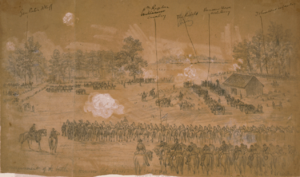Battle of Hanover Court House
| Battle of Hanover Court House | |||||||
|---|---|---|---|---|---|---|---|
| Part of the American Civil War | |||||||
 Commencement of the battle of Hanover Ct. House. 1:45 PM. Alfred R. Waud, artist, May 27, 1862. |
|||||||
|
|||||||
| Belligerents | |||||||
|
|
|
||||||
| Commanders and leaders | |||||||
| Fitz John Porter | Lawrence O'Bryan Branch | ||||||
| Strength | |||||||
| 12,000 | 4,000 | ||||||
| Casualties and losses | |||||||
| 355–397 | 930 | ||||||
The Battle of Hanover Court House, also known as the Battle of Slash Church, took place on May 27, 1862, in Hanover County, Virginia, as part of the Peninsula Campaign of the American Civil War.
On May 27, elements of Brig. Gen. Fitz John Porter's V Corps extended north to protect the right flank of Maj. Gen. George B. McClellan's Union Army of the Potomac. Porter's objective was to deal with a Confederate force near Hanover Court House, which threatened the avenue of approach for Union reinforcements that were marching south from Fredericksburg. The smaller Confederate force, under Colonel Lawrence O'Bryan Branch, was defeated at Peake's Crossing after a disorganized fight. The Union victory was moot, however, for the Union reinforcements were recalled to Fredericksburg upon word of Maj. Gen. Nathaniel P. Banks's rout in the Shenandoah Valley at First Winchester.
Confederate General Joseph E. Johnston withdrew his 60,000-man army from the Virginia Peninsula as McClellan's army pursued him and approached the Confederate capital of Richmond. Johnston's defensive line began at the James River at Drewry's Bluff, site of the recent Confederate naval victory, and extended counterclockwise so that his center and left were behind the Chickahominy River, a natural barrier in the spring when it turned the broad plains to the east of Richmond into swamps. Johnston's men burned most of the bridges over the Chickahominy and settled into strong defensive positions north and east of the city. McClellan positioned his 105,000-man army to focus on the northeast sector, for two reasons. First, the Pamunkey River, which ran roughly parallel to the Chickahominy, offered a line of communication that could enable McClellan to get around Johnston's left flank. Second, McClellan anticipated the arrival of the I Corps under Maj. Gen. Irwin McDowell, scheduled to march south from Fredericksburg to reinforce his army, and thus needed to protect their avenue of approach.
...
Wikipedia
